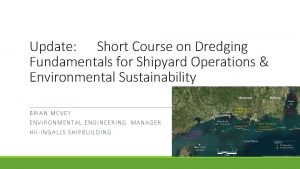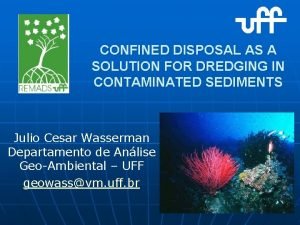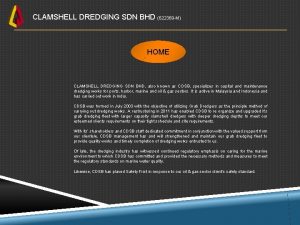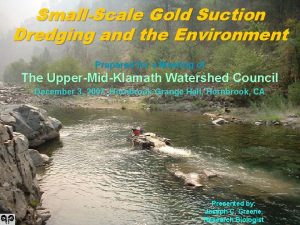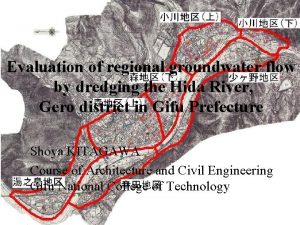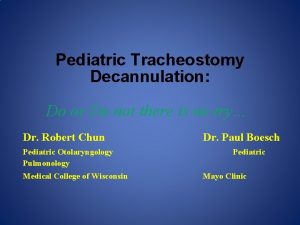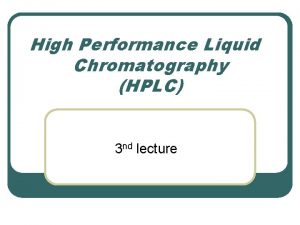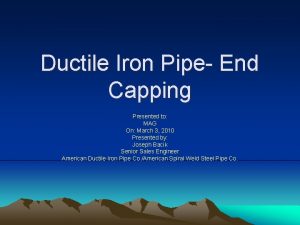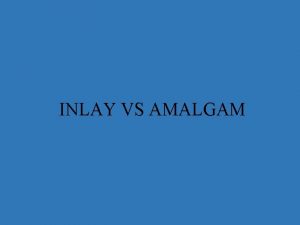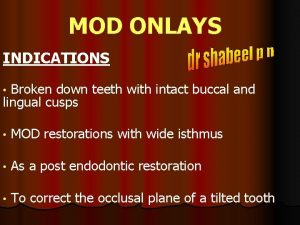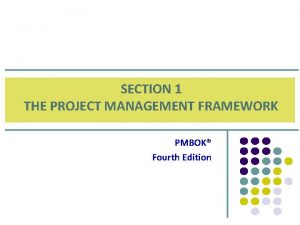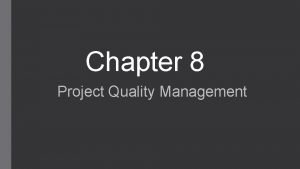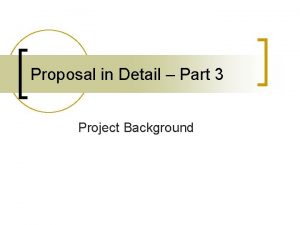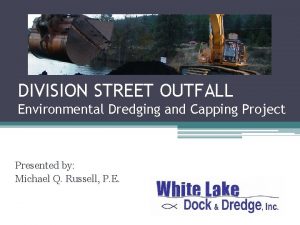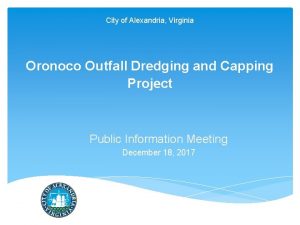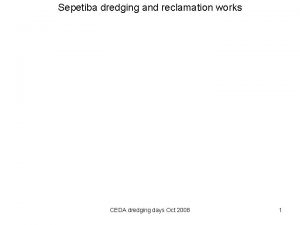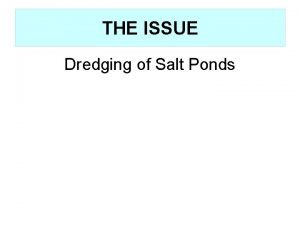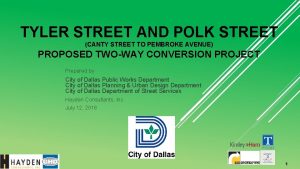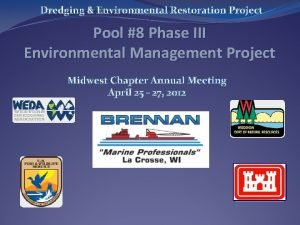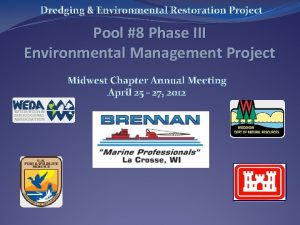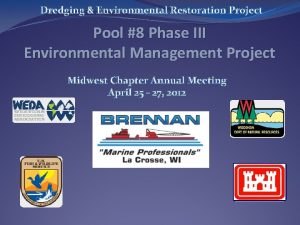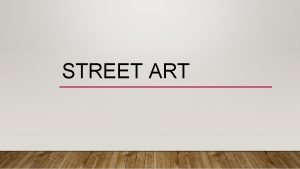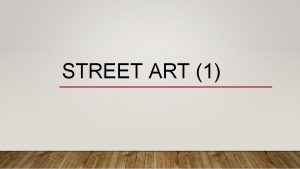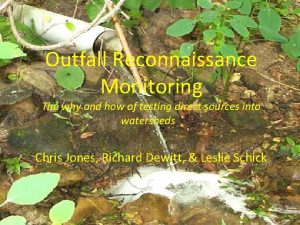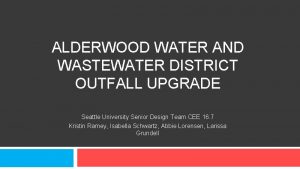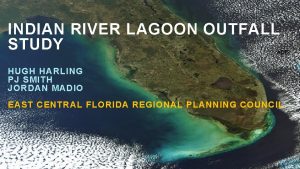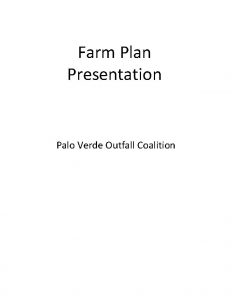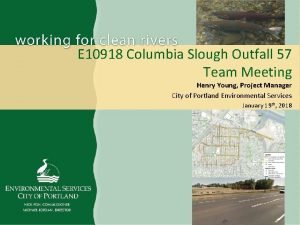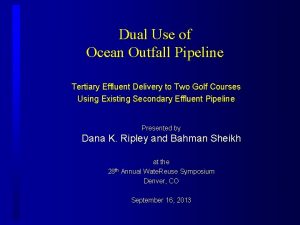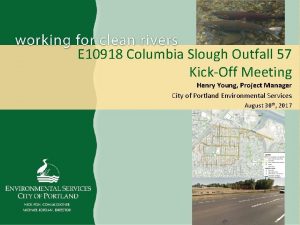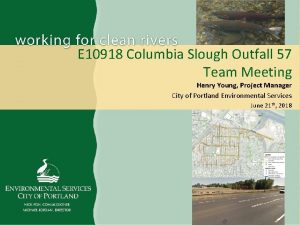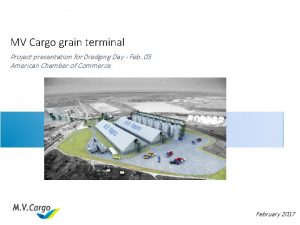DIVISION STREET OUTFALL Environmental Dredging and Capping Project






























- Slides: 30

DIVISION STREET OUTFALL Environmental Dredging and Capping Project Presented by: Michael Q. Russell, P. E.

Project Sponsors: USEPA – GLNPO State of Michigan Prime Contractor: LKR – Lata Kemron Remediation, LLC Dredging/Capping Subcontractor: White Lake Dock & Dredge, Inc

Project Specifics: • Mechanical Dredge with Turbidity Enclosure • Depths from 2’ to 28’ and narrow confines • Dredge Quantity: 54, 709 CY • In Barge Stabilization and Upland Disposal • Cap Quantity: 102, 656 CY • Locally Sourced Sand • Estimated 370 Timber pilings unknown length • Remove and clean 51 mooring anchorages.

Initial Issues: • Original as designed offloading staging and dewatering area in a busy city park. Festivals and other activities throughout the summer would be problematic and require periodic shutdown of operations. • Initial studies used an arbitrary review with low frequency fathometer. This told us that their would be additional non pay materials and potential issues with payment surveys. • No information on piling or debris. • Wide Variety of types of materials expected due to varying depths. • Precise/surgical dredge limits and confined areas within the outfall “boot” • Contour Dredging. • Capping Verification using bathymetric survey with low frequency.

Overall View Original:

Solutions Prior to Start: • Secure a private location adjacent to the project for offloading and material staging, eliminating the use of the Public Park. • Use In-Barge stabilization to replace large dewatering area and enable direct loading of spoils into over the road trucks to minimize rehandling. • Insist on compliance with USACE survey standards for payment and verification of dredge volumes. • Utilize an Environmental buckets capable of digging and removing piling, debris, sand mud. • Use full real time RTK dredge monitoring system for all digging and capping activities. • Have flexible shallow draft dredge and small barges to segregate dredge spoil types and debris. • Utilize a turbidity curtain lift gate for ingress and egress of near shore areas. • Utilize core samples in conjunction with surveys for cap verification.

Secure Private Location: Project Area Secured Dock Original Staging area in City Park

Surveying Issues: • An interferometric multibeam system was initially selected to perform payment surveys. This type of multibeam systems coverage is 10 to 12 times the depth of water. This broad coverage is WAY beyond USACE standards. • Multibeam systems regardless of type and low frequency single trace are not well suited to shallow water. • The Client also wanted to match the 2008 design investigations as close as possible. The 2008 survey was conducted with low frequency single trace, which ignore the softer materials on top of the sediment that the multibeam would capture, increasing the required dredge volume • Since multibeam surveys are only high frequency surveys, the Surveyor wanted to arbitrarily adjust the multibeam results recorded to attempt to mimic 2008 results. • WLDDI worked with LKR and EPA to determine the best suited methodology. Since low frequency type results were desired, it was agreed to utilize low frequency single trace surveys in waters deeper than 6 feet and to use high frequency single trace surveys in waters less than 6 feet deep.

Dredge Equipment: • Utilize Case CX 460 excavator with 70 foot reach and custom environmental enclosure for dredging all near shore and debris laiden areas. • Utilize Case or Sennebogen 840 material handler with 2. 5 CY environmental clamshell bucket and turbidity box for offshore deeper areas. • All dredging and capping with real time RTK system. • Utilize shallow draft sectional barges to enable access to restricted boot area and shallow shorelines. • Utilize lift gate along with 1, 100 feet of turbidity curtain to work the near shore and boot areas.

Project Images: Industrial Waste Fill Encountered along shore

Project Images: Industrial Waste Fill Encountered along shore

Project Images: Predominant Sand Encountered along shore and various areas.

Project Images: Typical Polymer Stabilized Materials.

Project Images: Typical direct offloading operations.

Project Images: Working within turbidity Enclosure.

Project Images: Offloading debris and sand into rehandling/drying bed.

Project Images: Typical Dredging/Capping operations.

Additional issues • Numerous survey problems. Payment surveys by third party representative performed with improper offsets, wrong frequencies and other unknown issues. Surveys never incorporated buffer zone around the work area, trimmed to neat line. Thorough review by WLDDI uncovered many irregularities. • Submerged pier was larger that originally thought, nearly double amount of pilings and large amounts of slab wood. • Perception problems with local interests group regarding buckets used. Expectation of “Environmental Bucket” often elevated above reality. Impossible to dig debris, piling and hard materials with conventional environmental bucket. • Numerous areas were encountered where post dredging confirmation samples were still above threshold contamination levels, required redredging and or additional cap. • Small redredge areas needed to be resurveyed and additional quantities computed. Improper methods continued to be used by 3 rd party surveyor.

Example of Differences: Inconsistent results and in depth review led to numerous issues including improper offsets, inversion of high and low frequency soundings and many other issues.

Example of Differences: Inconsistent results and in depth review led to numerous issues including improper offsets, inversion of high and low frequency soundings and many other issues.

Project Images: Massive amounts of slabwood encountered in pier removal.

Project Images: Massive amounts of slabwood encountered in pier removal.

Project Images: Massive amounts of slabwood encountered in pier removal.

Project Images: Double anticipated piles in pier removal.

Project Images: Core samples taken to verify sand cap thickness

Resolution to Field Problems • WLDDI changed dredging equipment implemented to deal with additional timber pilings and debris as well as hard bottom sediment • Diligent hydrographic check surveys performed to ensure proper QA/QC of 3 rd Party Results. Use proper techniques and equipment. • Conduct Numerous core samples post cap to verify and QA/QC results and confirm errors in 3 rd party surveys.

• Fine tuning and minor modifications to dredging methods and in barge stabilization processes allowed the majority of dredge spoils to be direct loaded into trucks for disposal. • Flexibility of equipment and crew allowed for rapid changes in work assignments. • Performed capping operations on night shift and dredging operations during day shift. • Modifications in task were also performed when possible to allow for work during all but the worst of weather encountered. Exposed areas were tackled on calm days and protected areas were saved for poor weather windows.

Prove Inaccuracy of Surveys: Re dredged areas in red outline, note lack of contours. No extra lines run by 3 rd party to define 100’x 100’ redredge areas. 30’ spaced sections ran.

Prove Inaccuracy of Surveys: Redredge areas readily evident, even without borders. Note the detailed depressions from moorings. Not evident on single trace. Re dredged areas in red outline, note detail of contours. Multibeam coverage at 2 times depth. Get paid for work performed.

Conclusions Questions • Flexible approach enabled us to change tasks as best suited the project to enable on time completion. • Have or hire survey professional to QA/QC results of any third party survey. If not you are tripping over dollar bills to pick up pennies. • Trained personnel and modern positioning systems are an integral part of completing complicated projects. WWW. WLDDI. COM
 Western dredging association
Western dredging association Confined space dredging
Confined space dredging Clamshell dredging sdn bhd
Clamshell dredging sdn bhd Caught suction dredging in california
Caught suction dredging in california Dredging
Dredging Dredging
Dredging Tracheostomy capping trial
Tracheostomy capping trial Tablet mottling
Tablet mottling Hplc lecture
Hplc lecture American ductile iron
American ductile iron Autosoftcapping
Autosoftcapping Bevel in inlay
Bevel in inlay Indirect pulp capping
Indirect pulp capping Indications for onlay
Indications for onlay Autosoftcapping
Autosoftcapping Long division and short division
Long division and short division Long division vs short division
Long division vs short division Long division vs synthetic division
Long division vs synthetic division Math synthetic division
Math synthetic division Wireless health
Wireless health Pecan street project
Pecan street project Enterprise environmental factors in project management
Enterprise environmental factors in project management Methodology of environmental education
Methodology of environmental education Enterprise environmental factors in project management
Enterprise environmental factors in project management The role of project management in achieving project success
The role of project management in achieving project success Project background for project proposal example
Project background for project proposal example Modern process transitions in spm
Modern process transitions in spm How to reduce project duration
How to reduce project duration Modern project management began with what project
Modern project management began with what project Project evaluation in software project management
Project evaluation in software project management Importance of software project management
Importance of software project management
